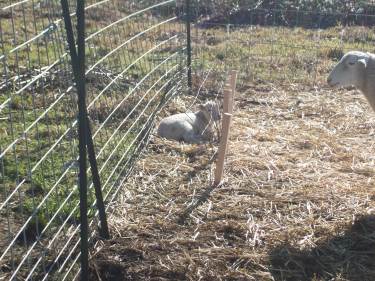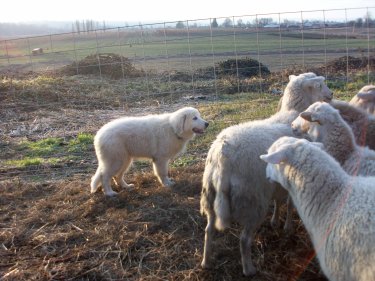 Last week I received a large order from Premier Supplies: 320 feet of portable “Electronet” fencing, and a portable fence charger with a solar panel. My long-term plan for this fencing was to help with rotational grazing and cleaving up our pastures into smaller sections. But, the short-term need was to be able to fence the dog in such a way that she can guard the sheep, but not wrestle with the lambs!
Last week I received a large order from Premier Supplies: 320 feet of portable “Electronet” fencing, and a portable fence charger with a solar panel. My long-term plan for this fencing was to help with rotational grazing and cleaving up our pastures into smaller sections. But, the short-term need was to be able to fence the dog in such a way that she can guard the sheep, but not wrestle with the lambs!
So, here they all are, in their temporary “feedlot” conditions. This little pen’s original purpose was to wait out any floods or potential floods, it is up on the hill near the house. But, it became a lifesaver when the coyotes became a problem, and the small quarters were necessary for the dog and sheep to become acquainted. With the arrival of the hotwire, I was able to make a “moat” around the center pen, so the ewes and lambs can be in there, and the dog surrounds them in an outer circle. It’s nice to have lambing happening close to the house, so I can monitor them frequently.
I put the ram in with the dog, so she’d have some company. She gets upset if she’s segregated from the sheep, or even some of the sheep, and spends her time trying to figure out how to reunite with them. This small adjustment in her space was also an attempt to gradually introduce her to the hotwire concept, in a familiar area, to reduce the trauma of it. Dogs often have a very hard time with electric shock, but it will be a necessary part of her environment, so she must learn about it!
We had one more lamb today, and the remaining three ewes should lamb any time. Once that is done, I can move the whole shebang back down to the pasture, and fence the ewes and lambs inside hotwire until the lambs are big enough to contend with the dog. I can fence the dog in, too, if I feel like I can’t catch her. I’m still working on that part.
 Here is the electric fence charger. It’s a rechargeable 12-volt battery, and the solar panel is more of a “booster” to help get a couple more days out of each charge. It’s supposed to last a week or two between chargings. The dog learned right quick to stay away from it, she is very afraid of it. And, the sheep are really too mellow to even challenge it. So, when I’m around, I can leave it turned off. But, at night, hopefully it’ll not only ensure the sheep and the dog stay in, but should keep the coyotes out.
Here is the electric fence charger. It’s a rechargeable 12-volt battery, and the solar panel is more of a “booster” to help get a couple more days out of each charge. It’s supposed to last a week or two between chargings. The dog learned right quick to stay away from it, she is very afraid of it. And, the sheep are really too mellow to even challenge it. So, when I’m around, I can leave it turned off. But, at night, hopefully it’ll not only ensure the sheep and the dog stay in, but should keep the coyotes out.
So far, I like the Electronet. It was very quick and easy to set up. I’ll have to comment again the first time I take it up and move it, whether I manage to keep it from becoming a tangled mess! It does sag a bit on uneven ground, which makes it touch the grass more, which will shorten the battery’s life. But, overall, I think it’s a great tool, and will give us a lot of flexibility in grazing different places on the property; and possibly offering to graze the neighboring property, which has recently been a challenge for the owners to maintain.
 Our livestock guardian dog (who still doesn’t have a name!) is doing pretty well. She’s definitely got the right stuff- big bark, loves the sheep, weatherproof coat, and just lays around most of the day. But, right now, she is still incredibly SILLY- just like any four month old dog would be.
Our livestock guardian dog (who still doesn’t have a name!) is doing pretty well. She’s definitely got the right stuff- big bark, loves the sheep, weatherproof coat, and just lays around most of the day. But, right now, she is still incredibly SILLY- just like any four month old dog would be. The second thing I tried was making a creep for the lamb to get into, that would keep the dog out. I made an open-ended tunnel out of a grid of wire, so that even if she did a bunker crawl in after him, he could exit the other end. I showed him this, and he seemed to “get it”- I often saw him sleeping in there, and the dog couldn’t do much to him. But, I the ewes kept wrecking the tunnel. They are shedding now, and are itchy, and they found that cramming their huge, pregnant bodies in there made for a splendid all-over scratching tube. 😛 But then they’d get stuck in there, and brute-force their way out, wreaking havoc with my petite lamb hut.
The second thing I tried was making a creep for the lamb to get into, that would keep the dog out. I made an open-ended tunnel out of a grid of wire, so that even if she did a bunker crawl in after him, he could exit the other end. I showed him this, and he seemed to “get it”- I often saw him sleeping in there, and the dog couldn’t do much to him. But, I the ewes kept wrecking the tunnel. They are shedding now, and are itchy, and they found that cramming their huge, pregnant bodies in there made for a splendid all-over scratching tube. 😛 But then they’d get stuck in there, and brute-force their way out, wreaking havoc with my petite lamb hut. Here’s how I think it’s going to work integrating the LGD into the mix. I’m not confident that all will play out as planned. But I’ll have to be flexible and adjust the plan as I see how things are going, because I don’t really know how things will go!
Here’s how I think it’s going to work integrating the LGD into the mix. I’m not confident that all will play out as planned. But I’ll have to be flexible and adjust the plan as I see how things are going, because I don’t really know how things will go! Well, here she is. Serendipitously, when I needed a livestock guardian dog (LGD), I was able to find one in a week’s time. My friends Sara Jo and John had a litter last fall, and this girl was the only one left. She is a four month old Maremma.
Well, here she is. Serendipitously, when I needed a livestock guardian dog (LGD), I was able to find one in a week’s time. My friends Sara Jo and John had a litter last fall, and this girl was the only one left. She is a four month old Maremma.